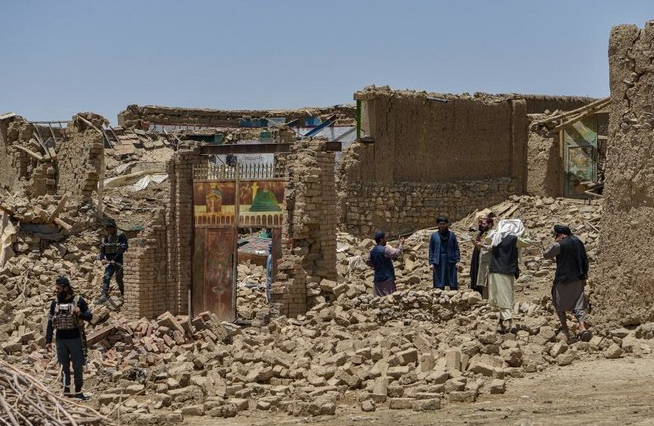A powerful magnitude-6.3 earthquake followed by strong aftershocks has killed about hundreds of people in the western Afghanistan, the country’s national disaster authority said as reported by Associated Press. Taliban spokesman has said that nearly 2,000 people have been killed due to the powerful earthquakes, as reported by AP.
The United States Geological Survey said the epicentre of the magnitude 6.3 quake was 40 kilometres (25 miles) northwest of the region’s largest city Herat. It was later followed by three very strong aftershocks, measuring magnitude 6.3, 5.9 and 5.5 magnitude, as well as lesser shocks. Earlier, the Geological Survey had also said that the eight aftershocks with magnitudes between 4.3 and 6.3 followed.
There is a discrepancy about the number of deaths in Afghanistan. The Taliban spokesman said that almost 2,000 people died. Bilal Karimi, a government spokesman told AFP that the death toll from a series of earthquakes in remote western Afghanistan rose sharply Sunday to “more than 1,000.” “Unfortunately, the casualties are practically very high… the death toll is more than one thousand people,” Bilal Karimi told AFP. However, Red Crescent spokesman Erfanullah Sharafzo said that the powerful earthquake have killed 500 people, Reuters has reported.
Discrepancy in number of deaths was seen earlier also. The United Nations had given a preliminary figure of 320, but later added the figure was still being verified. The local authorities gave an estimate of 100 dead and 500 injured, according to the same update from the UN Office for the Coordination of Humanitarian Affairs, as reported by AP.
Disaster authority spokesperson Mohammad Abdullah Jan said four villages in the Zenda Jan district in Herat province bore the brunt of the quake and aftershocks.
As per UN update, 465 houses had been reported destroyed and a further 135 were damaged. “Partners and local authorities anticipate the number of casualties to increase as search and rescue efforts continue amid reports that some people may be trapped under collapsed buildings,” the UN said as quoted by AP.
Discrepancy in number of deaths was seen earlier also. The United Nations had given a preliminary figure of 320, but later added the figure was still being verified. The local authorities gave an estimate of 100 dead and 500 injured, according to the same update from the UN Office for the Coordination of Humanitarian Affairs, as reported by AP.
Disaster authority spokesperson Mohammad Abdullah Jan said four villages in the Zenda Jan district in Herat province bore the brunt of the quake and aftershocks.
As per UN update, 465 houses had been reported destroyed and a further 135 were damaged. “Partners and local authorities anticipate the number of casualties to increase as search and rescue efforts continue amid reports that some people may be trapped under collapsed buildings,” the UN said as quoted by AP.
As per United Nations Office for the Coordination of Humanitarian Affairs (UNOCHA) in Afghanistan, in total, 4,200 people (600 families) are assessed to have been affected to date, including 1,400 IDPs (300 families). Mahal Wadakah is understood to be the worst affected village. Additionally, an estimated 300 families (2,100 people) are reported to have been displaced to Herat City where they are living in abandoned buildings.
Telephone connections went down in Herat, making it hard to get details from affected areas. Videos on social media showed hundreds of people in the streets outside their homes and offices in Herat city. Herat province borders Iran. The quake also was felt in the nearby Afghan provinces of Farah and Badghis, according to local media reports. Abdul Ghani Baradar, the Taliban-appointed deputy prime minister for economic affairs, expressed his condolences to the dead and injured in Herat and Badghis.
Meanwhile, earlier in June 2022, a powerful earthquake had struck a rugged, mountainous region of eastern Afghanistan, flattening stone and mud-brick homes. The quake considered as Afghanistan’s deadliest in two decades, killed at least 1,000 people while injured about 1,500 people.





